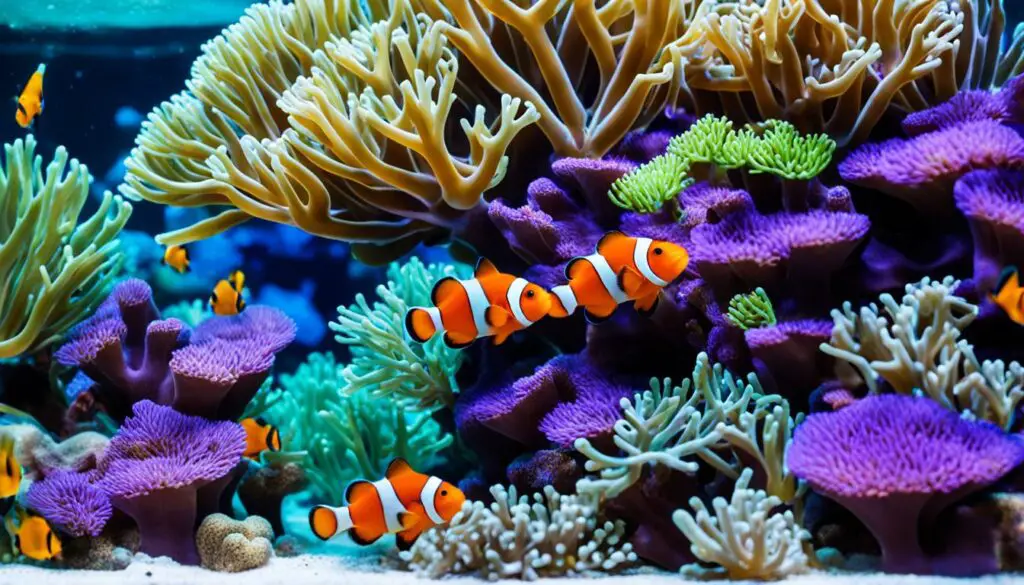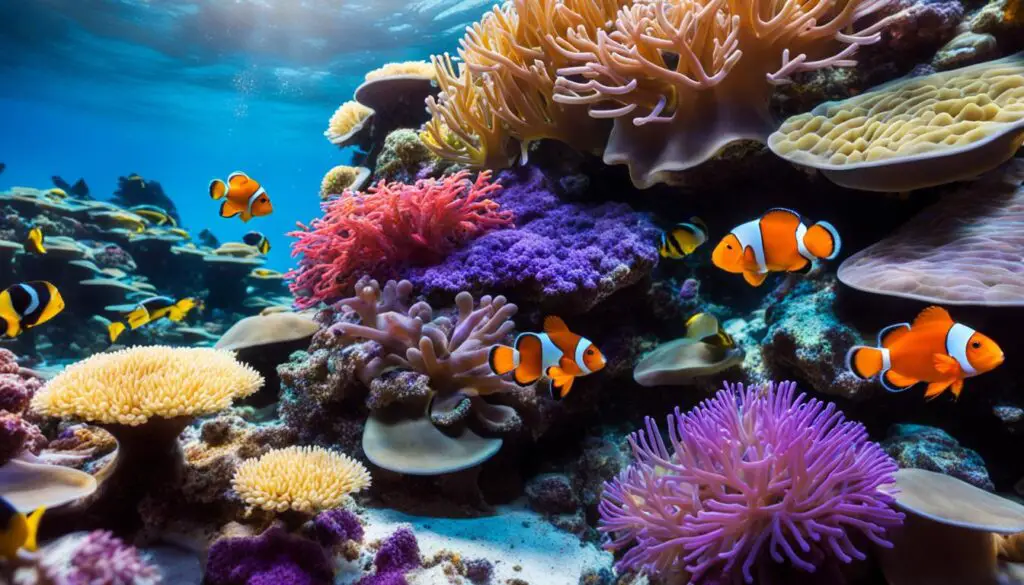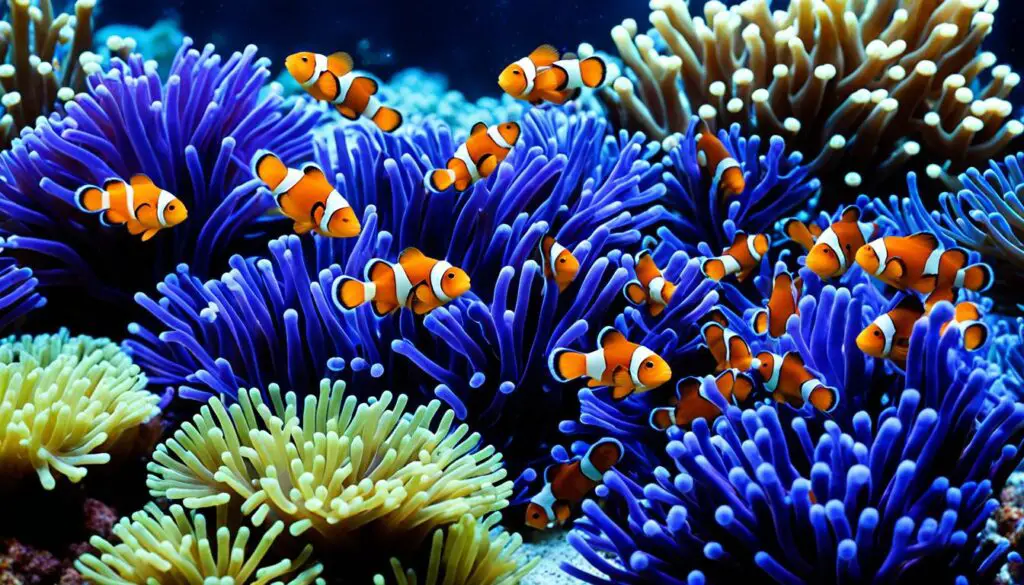The Dynamic Movement of Clownfish: A Visual Exploration
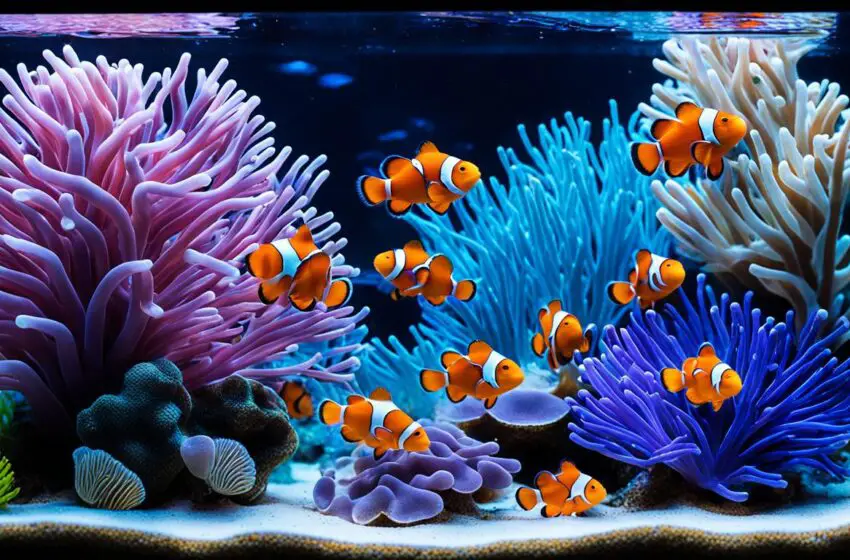
The way clownfish and sea anemones work together is key to a healthy ecosystem. This is especially true in settings like a clownfish tank. The health and survival of both the anemones and clownfish depend on managing their relationships well.
Studies have found problems like high death rates and not enough new clownfish. This has led to fewer clownfish sea anemones over time. This issue then affects the numbers of anemonefish. To protect both groups, we must really look into these issues and find solutions.
Key Takeaways:
- Clownfish tank ecosystem balance relies on understanding population dynamics.
- High mortality rates and low recruitment contribute to the decline of clownfish sea anemones.
- Sustainable management practices are essential for the long-term health and survival of clownfish and sea anemones.
- Population decline impacts the population structure of anemonefish, creating a negative feedback loop.
- Demographic analysis can inform recommendations to prevent local extinction.
The Importance of Sea Anemone Population Dynamics
Sea anemones are key in keeping fish tanks with clownfish balanced. They are essential for the fish’s well-being. These sea creatures work together in a special way. Their numbers and health are important for both the anemones and the clownfish.
Studying sea anemones in the Red Sea has shown how vital they are. If there are fewer sea anemones, the fish suffer. This causes a harmful cycle that can hurt both species and their home.
It’s vital to protect sea anemones and clownfish by managing their environment well. We need to know about how many anemones die or are born and what homes they have. This helps create plans that can help them survive.
“The decline of habitable sea anemones poses a significant threat to both the anemones and the clownfish that rely on them for survival. Through sustainable management practices, we can preserve these delicate ecosystems for future generations.”
The Impact of Sea Anemone Population Dynamics
The connection between sea anemones and anemonefish is strong. If there are not enough anemones, the fish can’t live and breed well. This hurts both of them, making survival harder.
When sea anemones decrease, it affects the whole tank. They provide food and shelter for the fish. Without them, the balance of the tank is in danger. This is bad for all life there.
Knowing about sea anemones helps us keep the tank healthy. We can then make choices that are good for everyone. This means looking after their homes, not taking too many, and helping new anemones grow.
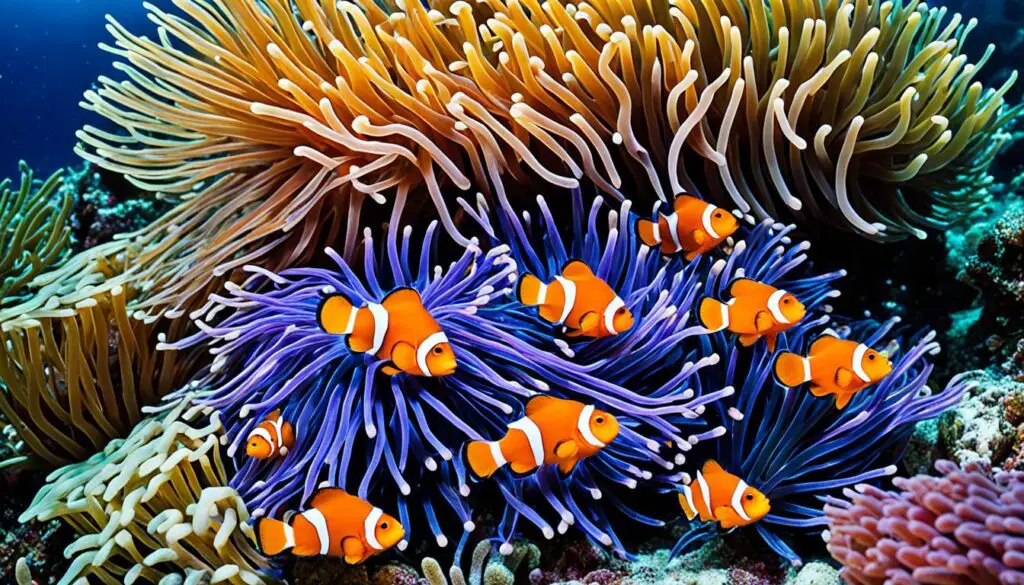
The Need for Sustainable Management
We must manage fish tanks with sea anemones and clownfish well. This means fishing responsibly, protecting their homes, and caring for their environment.
“Sustainable management is crucial for preserving the delicate balance between sea anemones and clownfish. By implementing conservation strategies and promoting habitat protection, we can safeguard the future of these unique and mesmerizing creatures.”
Good management stops sea anemones from being overused. It helps new sea anemones grow, ensuring their homes are the best. By focusing on sea anemones and their friends, we can have a tank that thrives for years.
The Role of Genetics in Clownfish Diversification
Researchers have looked into how clownfish and sea anemones work together. They found it makes clownfish species grow quickly and look alike. These changes help them live with and use their sea anemones.
By studying their genes, we found interesting things. Like, how their genes once mixed with other fish types. This, along with their genes changing quickly and many transposable elements, made clownfish able to live in many places and eat different foods.
One cool thing is, even though different clownfish families live far apart, they sometimes look and act the same. This is because their genes can make them develop similar traits. It helps them survive in their own areas.
| Genomic Elements | Significance |
|---|---|
| Transposable Elements | Contributes to genomic plasticity and rapid evolution, facilitating adaptation to new environments. |
| Accelerated Coding Evolution | Leads to the development of unique phenotypes, allowing clownfish to exploit different ecological niches. |
| Incomplete Lineage Sorting | Results in genetic variation within clownfish populations, contributing to their overall diversification. |
| Ancestral Hybridization | Introduces novel genetic material into the clownfish gene pool, promoting genetic diversity and adaptation. |
Some clownfish species change because natural selection likes their genes linked to friendship and community life. These genes help make a very special social order among the fish. This order helps the strongest fish keep control over the group.
To sum up, how clownfish adapt and change is heavily linked to their genes. Their genes, like quick-mixing and specific selection, are key to their survival. Learning about their genes helps us see how nature and sea anemones have shaped them.
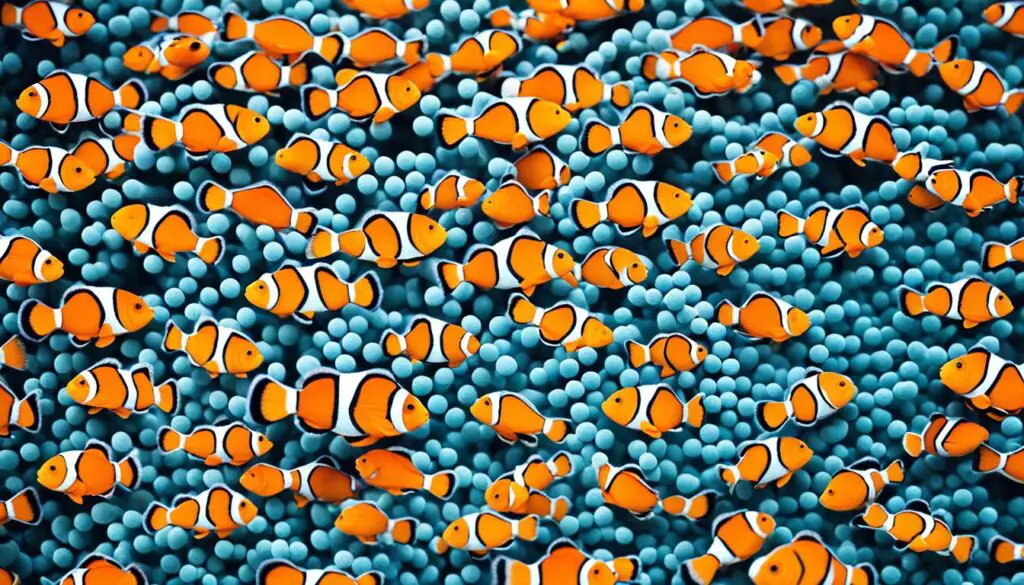
Conclusion
Keeping a balanced home for clownfish is key to their and their sea anemone friends’ health. If sea anemones vanish, clownfish numbers drop too. This bad cycle endangers them both. We must use smart ways to keep them safe and well.
Knowing how sea anemones and clownfish impact each other helps both species survive. We need to make sure there are enough healthy homes for clownfish. We also must look after the places where sea anemones live, like coral reefs. Learning about their genes helps us protect them and their homes better.
As fans of clownfish, it’s up to us to keep their world in balance. With the right care, both the fish and their sea friends can live well together. Let’s aim for a world where clownfish can sparkle and stay for a long time.
FAQ
What is the role of sea anemones in a clownfish tank ecosystem?
Sea anemones are key in a clownfish tank’s balanced life. They are a safe home for clownfish, keeping them safe from enemies. Also, sea anemones feed the fish, making sure they have food.
How do the population dynamics of sea anemones affect clownfish?
The numbers of sea anemones directly change how many clownfish there are. If anemones decrease, so does the clownfish population. This shift affects where the fish live, upsetting the tank’s balance.
Why is understanding the population dynamics of sea anemones important?
It’s essential to know sea anemones’ population change for good tank care. Understanding this lets us keep anemones and clownfish from disappearing. It keeps the tank’s life healthy for the long run.
How can sustainable management practices be applied to sea anemones and clownfish?
Good care means watching sea anemone numbers and protecting their homes. It also involves careful breeding and trading of clownfish. These steps help both sea creatures thrive together in the tank.
Can genetic factors influence the diversification of clownfish?
Yes, genes greatly shape clownfish’s diversity. Research shows that genes affect how social and ecological they are. This leads to their unique changes and traits over time.
What is adaptive radiation in clownfish?
Adaptive radiation is when clownfish kinds quickly change and spread. They do this to fit different habitats and climates. This way, various clownfish with specific skills and looks develop.

